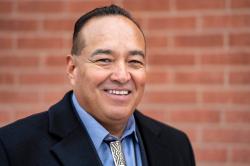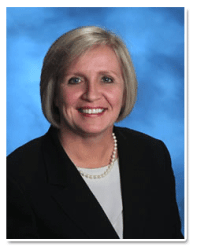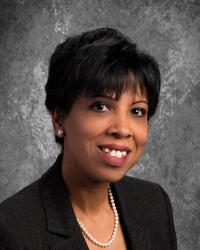The ongoing pandemic has challenged schools in many ways over the past two years, ranging from the need to provide students ongoing access to remote instruction to the tightrope walk between public health concerns and student rights to quality schooling during the constantly shifting conditions of the pandemic. Perhaps no challenge has been so acute as the operational and staffing challenges that have hit schools during the pandemic. Districts nationwide report unfilled vacancies for janitors, bus drivers, teachers aides, and substitute teachers, which have hobbled many schools.
To get an on-the-ground view of how staffing shortages are affecting schools, the Brown Center on Education Policy invited four district superintendents to share their challenges and attempts to meet them. Dr. Curtis Cain is superintendent of Wentzville School District in Wentzville, Missouri; Quincy Natay is superintendent of Chinle Unified School District in Chinle, Arizona; Dr. Kamela Patton is superintendent of Collier County Public Schools in Naples, Florida; and Dr. Noris Price is superintendent of Baldwin County School District in Milledgeville, Georgia. Their responses below have been lightly edited for length and style.
These superintendents make up the four finalists in AASA’s National Superintendent of the Year award for 2022. AASA, The School Superintendents’ Association, is a nonprofit organization that supports school leaders in the U.S. and across the globe, advocating for equitable access for all students to the highest quality public education.
Question 1: How have staffing issues taken shape in your district, and how have they impacted your students?
Cain: The COVID-19 pandemic has caused significant staffing challenges for school districts throughout our nation. My district in Wentzville, Missouri, has been impacted, too. At one point in January 2022, we had substitute-fill-rate percentages in the 40s for teaching and support staff, yet we found a way to keep our doors open. It meant office staff had substituted, collapsed sections, postponed other district efforts, and traveled to other buildings to work all in an effort to continue to meet students’ needs and keep school and classroom doors open.
Natay: This school year I have had 17 teaching positions that we have not been able to fill with appropriately and fully certified staff. A unique recruiting challenge for remote reservation districts is the inaccessibility of housing in the community. There are no homes for purchase, rentals are rare, and only Navajo residents of the local community can acquire a home-site lease to build a home here.
Research shows that the disparity between the caliber of teacher found in high-poverty/high-minority schools and low-poverty/low-minority schools has a massive impact on student achievement. My current teacher shortage means children in 1 out of 10 classrooms don’t have equitable access to the highly effective teachers they need to eliminate the opportunity gap.
Patton: We have been able to keep all our 50+ schools open and classrooms staffed by intensively utilizing our guest teacher (substitute teacher) pool of nearly 700 people, and by coming up with new ways to broaden the pool. The staffing challenges we are experiencing are similar to our colleagues across the country. These problems are heightened by the issue of workforce housing and the fact that Collier County, Florida, is an ideal, destination community for both young families and retirees.
Price: Our biggest staffing issue has been getting substitute teachers, paraprofessionals, school-nutrition workers, and bus drivers during the COVID-19 pandemic. The lack of substitutes has created numerous challenges, such as not having enough staff to cover classes as a result of a teacher being absent due to COVID-19, bus routes being combined or delayed due to not having enough bus drivers, and reducing the number of options for hot meals provided to students. Our substitutes are generally older and are afraid of contracting COVID-19 and getting seriously ill, or they have been offered more money to work for another school district, organization, or business. We have been fortunate that we have not had to shut down in-person learning due to staffing shortages.
Question 2: What are you doing to address these staffing challenges in the short term, and what needs to be done to improve this situation over the long term?
Cain: Encouraging people to stay home if they are sick as well as providing positivity rates for schools and the district as a whole —in concert with highlighting our district COVID-19 procedures and resources —have appropriately helped to inform our students, families, staff, and community members.
School and department leaders have also been granted additional autonomy to create and deploy innovative solutions to meet immediate needs. An example would be utilizing large indoor and outdoor spaces when conditions warrant.
Also, it is contradictory to ask staff to pour out to our students if their vessels are empty. Looking forward, the mental and emotional health of educators will be key factors in workplace satisfaction and retention of staff.
I do understand that we want to be done with COVID-19, though the truth is we cannot promise that COVID-19 is done with us. This pandemic has taught me that we cannot always predict what is right around the corner. In my opinion, we need to be prepared to pivot to additional mitigation measures if conditions suggest that we need to do so.
Natay: We leverage our fiscal resources to be among the most competitive districts in Arizona for teacher pay, cover 100% of premiums for employee health-care plans, offset dependent coverage, and offer recruitment and retention stipends. Chinle (Arizona) Unified School District teachers work in some of the finest school facilities anywhere, and they have abundant instructional resources. We place two academic coaches in every school who support teacher growth through job-embedded professional learning. We also provide convenient, affordable housing rentals for teachers.
Something that would help us maintain our 280 teacher housing units would be legislative action allowing staff housing construction under the definition of school facilities. Most districts don’t incur this expense, but as described above, housing construction and renovation is necessary for us to hire teachers in the Navajo community. Arizona’s adopted pathway allowing emergency teachers to become fully certified has made it possible for us to vet exemplary candidates for some vacancies. Legislation requiring a 3-to-5-year commitment for foreign teachers upon our sponsorship of their work visa would increase our candidate pool. Excellent teachers exist in this pool, but they often leave after visa sponsorship.
Patton: Collier County Public Schools (CCPS) has worked to build competitive teacher salaries (second highest out of 67 Florida districts) and offer many paid supplemental opportunities, full board paid health insurance for no cost to the employee, and pathways to grow within our organization. We hold recruitment activities and external recruitment events, specifically from our guest-teacher pipeline, and offer several career development programs. Bringing aboard substitutes (guest teachers and assistants) through our Guest 2 Teach program allows for job-embedded learning, an introduction to the classroom, and a glimpse of what it is truly like to be the teacher while working on certification supported by the district. The district also created other programs to help with recruitment. Grow 2 Teach promotes the teaching profession to current non-instructional staff and supports them through their education process and certification to become a teacher. Teach 4 Collier and Teaching in the Trades targets our educated community in Collier County who may want a career change or to return to work after retirement. Additionally, alumni connections allow staff to reach out to their alma maters and share CCPS opportunities.
Price: To remain a competitive school district and retain personnel, we significantly increased the daily rate of pay for substitute teachers and salaries for paraprofessionals, school-nutrition workers, and bus drivers. We also offered a retention bonus for any new employee and referral bonuses to current employees. We have used district leaders and anyone who does not have a classroom assignment to cover classrooms in need of a teacher, and have brought back retired teachers, too.
To address the ongoing teacher shortage in rural Georgia, the Baldwin County School District has partnered with Georgia College and Central Georgia Technical College to create a teacher pipeline. Rural districts typically do not have a deep pool of candidates to draw on from their own communities. Fewer rural high school graduates go on to postsecondary institutions than their urban and suburban peers. Many of those who do go on to college do not return to their home communities. Our district has decided to take these challenges head-on by implementing the high school Teaching as a Profession and Early Childhood pathways. These pathways will allow us to “grow our own” by providing dual-enrollment opportunities for students to start taking core college courses at Central Georgia Technical College. The goal is to have students graduate from high school with an associate degree; they will then transfer to Georgia College as a junior in the college of education with the same rights, responsibilities as other Georgia College students. We are still working out the details, but we will be the first school district in the state to implement this innovative model.
Question 3: Beyond staffing issues, what other challenges are commanding your attention this year?
Cain: We have to find a way to engage in discourse and debate—on a variety of topics—in a manner that looks different than some of the situations that districts are currently facing. There will always be differences of opinion, abilities, and beliefs. That has always been true in public schools. Difference does not have to evolve into distrust, and distrust does not have to morph into attack. Choice, options, and diversity are all issues that can be strengths if we encourage and create the conditions that allow respectful dialogue and variation in delivery.
Schools have been able to find a common ground and a greater good in the past, I have great confidence that we will do so in the future.
Natay: The pandemic has shined much needed light on public awareness of the inequities that exist in high poverty, rural/remote reservation school districts like mine. Although I have always made a priority of educating legislators about the unique infrastructure challenges that the children of my district face, I find that this year I have had more opportunities to influence decision-makers about the need for running water, electricity, improved roads, and broadband. The high stakes for children whose opportunity gaps have been widened even more by school closures demand my continued dedication to equity by elimination of these challenges.
Patton: Addressing unfinished learning tied to the pandemic is a top priority for Collier County Public Schools. Using Data Dialogues—a series of discussions among school and district leaders on student-progress monitoring—CCPS is ensuring that areas of concern are being addressed with a plan for interventions, as well as providing staff with the support to properly address unfinished learning.
Price: Beyond impacting physical health, the COVID-19 pandemic has presented many mental health challenges to students, faculty, and staff. We know the primary ways to improve or maintain well-being is the ability to take care of our physical health, connect with others, and find purpose in each day. To address the social-emotional needs of our staff, the school board approved our Employee Assistance Program, which is a confidential assessment, counseling, and referral system to address and improve upon the well-being of our staff 24/7. Alongside this program, we announced the opening of the Bee Well School-based Health Clinic. By opening the clinic, we are making sure that the health-care needs of our students, families, and employees are met, and that they have access to preventative and reactive health care such as vaccines, diagnosis of common illnesses, and annual checkups. We also placed a mental health service worker in each of our schools to provide counseling services to our students and implemented a social-emotional curriculum in all of our schools.
Special thanks to James Minichello of AASA for his help in producing this post.

![An air conditioning unit, top left, was added to this sixth-grade class room upgrade at Sherwood Middle School in Columbus on September 5, 2019, as part of Operation: Fix It, the five-year, 125-million plan funded by a 2016 bond issue to repair Columbus City Schools facilities. [Kyle Robertson/Dispatch]](https://www.brookings.edu/wp-content/uploads/2022/01/2021-08-25T154105Z_597664506_MT1USATODAY16623492_RTRMADP_3_AN-AIR-CONDITIONING-UNIT-TOP-LEFT-WAS-ADDED-TO-THIS.jpg?quality=75&w=500)






Commentary
How are staffing shortages affecting schools during the pandemic?
Perspectives from 4 superintendents
February 18, 2022